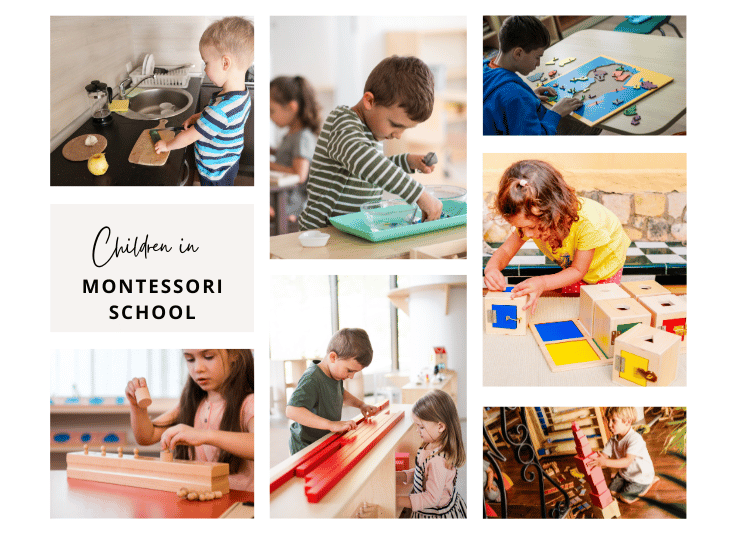As a Montessori teacher, I have the pleasure of observing the unique and engaging learning experience that takes place in my classroom every day. The Montessori approach to education is based on the idea that children are naturally curious and eager to learn, and it is my job as a teacher to provide them with the tools and guidance they need to explore and discover the world around them.
The Settling Period in Montessori Classroom
At times, during the start of the school year, it is sufficient to give the children the opportunity to speak freely. We may choose to play music, share snacks, or take a leisurely stroll to gather flowers or twigs to engage with nature.
One of my peer educators said, “In Montessori classrooms, there was no separation between indoor and outdoor spaces, and presentations were shorter and less frequent compared to modern classrooms. To encourage children to work outside, teachers would say, “There’s no such thing as bad weather, only inappropriate clothing.” The terrace was easily accessible for outdoor work, and students were only required to wear appropriate outdoor clothing when necessary”.
Also Check: Top 9 Principles of Montessori Education
In a Montessori classroom, we provide various tools such as information cards, magnifying glasses, miniature puzzles, trowels, painting essentials, and more to increase children’s interest and curiosity while considering their different needs. We encourage children to settle, observe, and question without rushing to complete an activity. There is no set time period or bell ringing to signal the start or end of activities. Instead, children are invited to participate in exercises as they feel ready. This approach helps maintain a balance between mental work and physical exercise, as children are constantly in contact with the seasons and the natural world.

A Typical Montessori Day in a Montessori Classroom
At the beginning of the day, the children arrive and are greeted with warm smiles in a welcoming environment. The classroom is prepared to promote independence and self-directed learning, allowing the children to choose their own activities and work at their own pace. This approach enables each child to explore their interests and learn at a level that is appropriate for them, whether they are working on basic skills such as pouring and sorting or more advanced concepts like math and language.
At the start of the day, the children gather for the Montessori circle time. During this time, we discuss topics such as the weather or the calendar, sing songs, and discuss any special events that day. It’s an opportunity for the group to come together, share ideas, and practice listening and speaking skills.
After circle time, the children engage in a morning work cycle. I observe them engrossed in a variety of activities. Some work with sandpaper letters, tracing the shapes of the letters, and learning to associate them with their sounds. Others build towers of different sizes with the pink tower, exploring concepts like size and dimension. Still, others count and sort objects or practice addition and subtraction with math activities. It’s fascinating to see how each child approaches their work with unique creativity and focus.
One of the things that set Montessori education apart is its emphasis on collaboration and respect for others. The classroom is designed to foster a sense of community, so there are often opportunities for collaboration and peer teaching. It is common to observe an older child assisting a younger one with a challenging task or explaining a concept they have already mastered. This not only helps the younger child to learn, but also reinforces the older child’s knowledge and understanding of the material.
In the afternoon, the group came together for circle time, where they sang songs, shared stories, and discussed topics of interest. This was a time for the children to come together as a community and share their experiences and ideas. They might talk about the changing seasons or learn about different cultures and traditions.
Curious to learn the difference between Montessori and kindergarten? Check out our detailed blog here.
This was followed by outdoor playtime, where the children were free to explore and play in a natural setting. They might climb trees, build forts, or play games together, all while developing their physical skills and enjoying the beauty of nature.
Walking off the line was a daily midday activity, often taking place outdoors. A small table with flags, glasses of water, and other items was brought out for this purpose. The children used a stick or small shovel to create a large circle or oval on the ground, although it was not as perfect as an indoor line. Music was played on the indoor piano, or sometimes the phonograph was brought out onto the balcony.
This is followed by an afternoon work period where the children concentrate on improving their skills in a quiet, serene setting. They engage in a variety of activities that cater to different developmental needs. These can include practical life activities such as opening and closing, screwing and unscrewing, or sensorial activities to enhance their senses. They may also be introduced to the Large Moveable alphabet box or math materials such as bead bars or number rods.
The idea is to provide opportunities to learn and develop a love for learning.
As the day comes to a close, I reflect on the unique and enriching learning experience that has taken place. The Montessori approach encourages children to become independent learners and thinkers, while also instilling a sense of community and respect for others. It is truly a joy to be a part of such a special learning environment, where each child can explore their own interests and develop at their own pace, all while learning the skills and knowledge they need to succeed in life.
In conclusion, whether it is a Montessori classroom or a traditional classroom, this is what we should all strive for in our classrooms.


